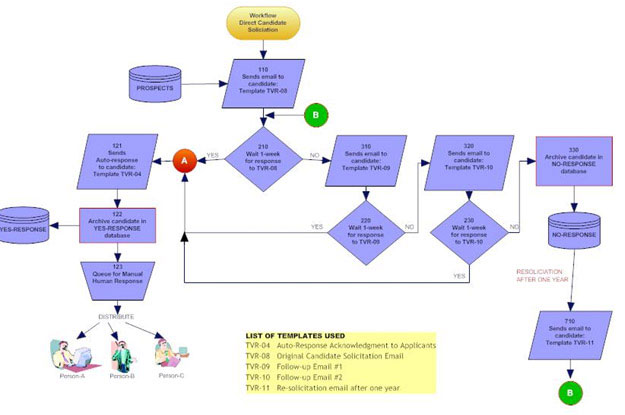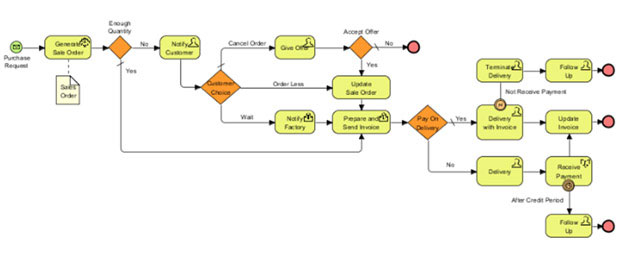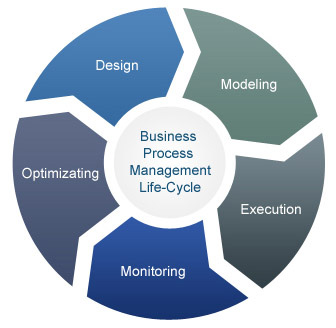BPM is a holistic approach to align all aspects of an organization with the wants and needs of clients. It is much more than just "process optimization." It seeks to change the entire organization with focus on business processes. Regardless of whether you are a member of the Board, a service technician, an internal auditor, a production engineer or a mailroom clerk, BPM touches you with professionally enriching experience and makes your organization more agile, more productive and more sustainable.
Definition
Business Process Management (BPM) is a discipline1 that seeks to study2, analyze2 and understand3 the processes that run a business, with the aim of deriving methodologies4 that could be selectively5 or collectively5 used for harnessing6, improving and creating processes to achieve operational efficiencies7, institutionalized knowledge8 and organizational resilience9.
Related annotations:
1. “discipline” = formal and structured approach
2. “study, analyze” = inquire into and model the processes; modeling is the recommended approach
3. “understand” = derive and define a collection of theories, concepts and ideas that lead to the development of a methodology;
4. “methodologies” = methods, policies, metrics, management practices and software tools
5. “selectively or collectively” = the theories, concepts and ideas will not all apply equally well to every situation; the BPM expert must choose and decide what best applies under what circumstances; experience matters!!!
6. “harnessing the processes” = BPM must “manage” the processes;
7. “operational efficiencies” = examples: business optimization (better business); business agility (quicker reaction to changes); alignment with the needs of the stakeholders (including customers); streamlining (better workflow); flexibility; standardization of processes within the enterprise; cost optimization; manpower optimization; automation optimization; etc. – you name it – take the holistic approach.
8. “institutionalized knowledge” = the knowledge about the business processes should belong to the organization and not reside inside the heads of individuals and be lost when these individuals leave the company; successful BPM must create a knowledge repository that belongs to the organization.
9. “organizational resilience” = ultimately BPM must seek to make the organization more robust; more immune to threats; more likely to survive in conditions where others fail; more likely to thrive in any market condition.
Business Processes
Let’s start with a commonly recognized and easily understood diagram.

As you may have noticed, this diagram is called a ‘workflow’ and not a ‘business process’. This is because there is a difference between a ‘business process’ and a ‘workflow’.
What is a Workflow?
A workflow consists of a sequence of connected steps. It is a depiction of a sequence of operations, declared as the work of a person, a group of persons, an organization of staff, or one or more simple or complex mechanisms. The flow being described often refers to a document that is being transferred from one step to another, but not necessarily so (as in the schematic above).
A workflow is a model to represent real work for further assessment, e.g., for describing a reliably repeatable sequence of operations for direct candidate soliciting (as in the schematic above).
A ‘business process’ is a more specific notion than workflow, and is distinguished from a workflow by the fact that it has well-defined inputs, outputs and purposes, while the notion of workflow may apply more generally to any systematic pattern of activity (such as all processes occurring in a machine shop).
What is a Business Process?
A business process is a collection of related, asynchronous, chronologically executed structured, well-defined activities that produce a well-defined outcome, which could be either a service or product.
Here is the schematic of a business process:

BPM considers processes to be strategic assets of an organization that must be understood, managed, and improved to deliver value added products and services to clients.
BPM Life Cycle
The typical BPM life cycle consists of the following activities that can be grouped into five categories:
1. Design,
2. Modeling,
3. Execution,
4. Monitoring, and
5. Optimization.

Design
This begins with the study and analysis of the current processes, and leads to the conception and design of the “to be” processes. At this stage it is still a theoretical design.
Areas of focus include representation of the process flow, the actors within it, alerts & notifications, escalations, Standard Operating Procedures, Service Level Agreements, and task hand-over mechanisms.
Good design is extremely important for the operational efficiencies of the business process management system.
Modeling
This stage takes the theoretical designs and models behavior by feeding variable data to the models. This helps stress the models and determine how the conceived business processes might operate under varied circumstances.
This is effectively the performance of "what-if analysis" on the processes: What if the regular supplier fails to deliver on time? What if the furnace shutdown takes twice as long as envisaged? What if 10% of my workforce does not turn up for work on a certain day? What if cash flow constraints reduce my liquidity by 30%?
Execution
Execution need not necessarily involve automation or the use of technology, but in reality it usually does.
Automation need not necessarily involve an available BPM software solution. It can be implemented using existing applications, EAI, bolt-on workflow engines, SOA and so on. Legacy IT environments are rarely conducive to BPM implementation.
BPM software that utilizes the latest BPM technology such as UML (Unified Modeling Language), BPMN (Business Process Modeling Notation) and business rules engines is extremely useful for execution and is the current best practice.
Execution involves human input at various stages that are too complex to automate.
Monitoring
In this stage we track individual processes, so that information on their state can be easily seen, and statistics on the performance of one or more processes can be provided. For example, such tracking determines the state of a vendor delivery (e.g. awaiting fulfillment, awaiting delivery, awaiting inspection, and so on) so that problems in its operation can be identified and corrected.
The degree of monitoring depends on what information the business wants to evaluate and analyze and how business wants it to be monitored, in real-time, near real-time or ad-hoc.
Process Mining
This involves the use of a set of methods and tools related to process monitoring, the purpose being the analysis of event logs extracted through process monitoring and the comparison of those event logs with a pre-determined Process Model. This validates and modifies the Process Models and helps detect defects before they occur.
Optimization
In this stage of the BPM life cycle, we identify potential or actual bottlenecks and other inefficiencies, where with reference to resource, cost or infrastructure, and fine tune the design of existing process based on this discovery so as to avoid problems and enhance business value. Process optimization begins with retrieving process performance information from modeling or monitoring phase.
BPM Technology
BPM purists do not see technology as integral to Business Process Management.
Must BPM necessarily mean “Technology”?
BPM is a management discipline and practice -- it is not software. It is perfectly possible to study, analyze, design and implement BPM solutions without purchasing any software.
Analogy: Transportation does not necessarily mean technology (car, train, ship, airplane, etc.). We can surely study, analyze and design an optimal route for getting from Point-A to Point-B. Sure, we can walk, but we usually add technology to make it an efficient, cost effective, scalable process.
BPM Suites are wonderful aids to improving process management, but they are expensive optional extras and need to be used with care and forethought.
Available BPM Technology
BPM tools establish a common language for business-IT alignment, and therefore form a bridge between Information Technology (IT) and Business to connect organizational and technological silos.
Typical BPM software consists of at least four critical components:
1. Process Engine: A robust platform for modeling and executing process-based applications, including business rules
2. Business Analytics: Enable managers to identify business issues, trends, and opportunities with reports and dashboards and react accordingly
3. Content Management: Provides a system for storing and securing electronic documents, images, and other files
4. Collaboration Tools: Remove intra- and inter-departmental communication barriers through discussion forums, dynamic workspaces, and message boards
Popular BPM offerings in the market include:
Pegasystems
Aris
Oracle BPM Suite
Lombardi
Appian
Savvion
Enterprise Architect
No Magic
BPM and Organizational Change
Everything changes, except change.
With the recognition of the fact that change must be managed, there has arisen a whole body of thought called OCM (Organization Change Management). In fact, it has even been claimed that “organizational change may well be the most oft-repeated and widely embraced term in all of corporate America.”10
BPM is an invaluable aid to effective change management and causes “the transformation of organizational change from an imprecise art with unpredictable outcomes into an engineering discipline with measureable outcomes.”11 While BPM is similar to Total Quality Management (TQM) or Continuous Improvement Process (CIP) methodologies in treating business processes as a strategic asset of the organization, BPM goes a step further by stating that this approach can be supported, or enabled, through technology to ensure the viability of the managerial approach in times of stress and change. In fact, BPM is an approach to integrate a "change capability" to an organization - both human and technological.
Annotations
1-9 are under Related Annotations (above).
10. Beer and Nohria, 2000a: cover
11. Smith and Fingar, 2007
|